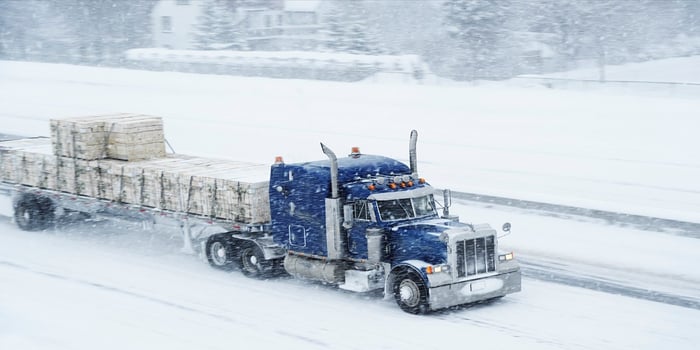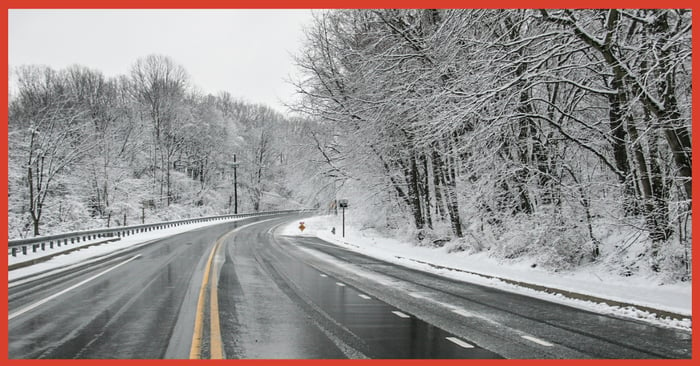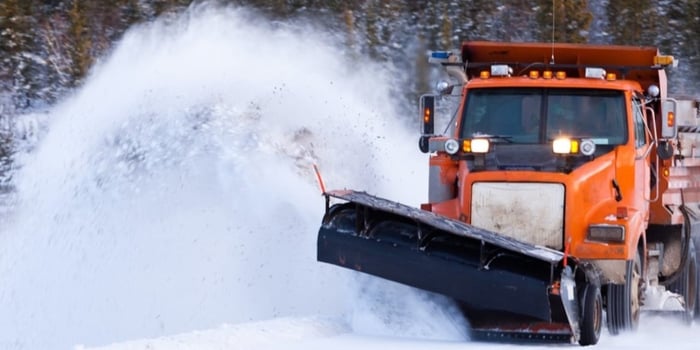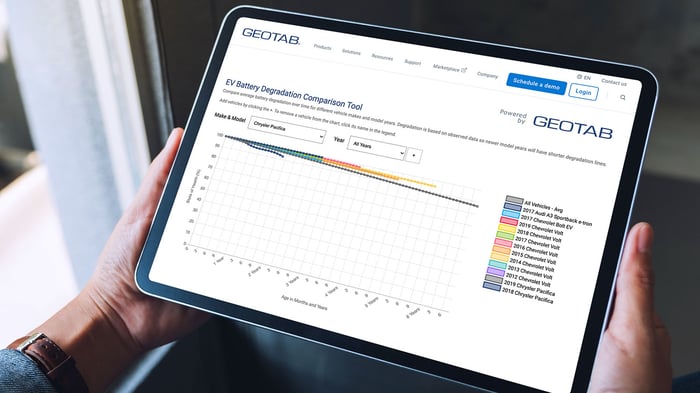
Winter preparedness has become increasingly difficult as the weather has become more unpredictable, but that doesn’t mean you can’t get ahead now.
Proactive maintenance is an essential part of managing your fleet efficiently. Planning ahead can also help you see a greater return on your investments. To help your fleet prepare for the winter season, we’ve compiled a comprehensive winter fleet preparation checklist so you can stay one step ahead.
Tip #1: Keeping tabs on your tires
Setting a reminder to have your tires rotated is a great way to start your winter fleet preparations. You might also want to consider changing any rib tread tires to lug treads for better vehicle handling and stability in tough road conditions.
In addition, tire pressure can be negatively affected by cold temperatures, causing them to slowly deflate. Deflated tires impact their tread life, vehicle fuel economy and overall safety, so monitoring this is a must to minimize risk. Consider installing a valve cap on each tire to prevent moisture and ice build-up in the tires’ valve cores. For regular check-ups, have your drivers check tire pressure as a part of their pre-trip inspections.
Tip #2: Protect your brakes
Brakes are always vital to driver and highway safety. This is even more true when road and weather conditions decline with snow, ice and slush. That’s why it is even more important to make sure your brakes are in tip top shape during the winter months.
Inspect air brake chamber housings for damage or corrosion and make sure dust plugs are properly installed and seated. Check for cuts or tears on the protective boots of air-disc-braked wheel-ends and guide pins if you have them. Additionally, make sure your vehicles’ air dryers and filters are working to prevent water freezing in your brake lines.
While you are at it, ask your mechanic to lubricate your vehicles’ automatic slack/brake adjusters (ASA/ABA’s) to purge any water, contaminates and old grease from the system. This will prevent corrosion and provide optimal stopping power.
Tip #3: Recharge your batteries
Cold weather stresses batteries and can cause them to drain faster. On top of that, the colder the engine is, the more energy that will be required of the batteries to start it.
To help prevent dead batteries in your fleet, measure and keep track of their volts when fully charged (with a 2,000 CCA tester), check that battery connections are tight and that terminals are clean.
Use one of Geotab’s default rules, "Battery Drain,” to help identify when battery power is running low. This rule identifies vehicles that have a battery voltage below 9 volts. An alert from this rule can help to identify general battery problems or to remind drivers to turn off their vehicle's lights. Something to keep in mind is that fully-charged battery voltages are 12.65 volts for flooded batteries and 12.85 volts for AGM batteries.
Protect your batteries from excessive drainage during the winter months by opting for batteries with thermal insulation during the summer months. Doing so will help you reap the benefits of heat-protected batteries all year round.
Tip #4: Check your vehicle’s electrical systems
During the winter, your drivers will likely be using the cab heating system, window defroster, lights and other functions more often due to shorter days and colder temperatures. Consider testing and reading the amperage requirements of these systems and specifying the alternator to suit.
You could also test the voltage drops on the line between the alternator and the battery to make certain the maximum current is running from the alternator. This will help everything using the battery to be fully supplied with power.
Tip #5: Inspect your cooling systems
First things first, you should inspect your vehicles’ heater and water hoses for wear and tear. After turning on the heater control valves and the engine has cooled down, pressure test the coolant to determine if it’s at the manufacturer’s recommended PSI. Additionally, pressure test the radiator cap for the correct PSI specifications.
Make sure every vehicle has enough antifreeze for top ups when needed. Water can cause the engine block to crack and freeze. It can also force plugs to pop out of the block.
Tip #6: Replace your compressed air systems
Replacing your air dryer cartridge every fall doesn’t just benefit your braking systems, but many of your vehicles' automated functions. To avoid oil deterioration on your cartridges’ seals, consider using an oil-coalescing cartridge.
Regularly draining your vehicle’s air tanks where there is likely to be an abundance of water, chemicals, salts and sand build up can help keep fleet vehicles in top shape.
Tip #7: Maintain your diesel systems
Diesel fuel can turn into a waxy gel in cold weather due to its paraffin content. To stop this from happening, fill up with an anti-gel blend that has a high cetane rating. Consider keeping anti-gel additives available to your drivers in case temperatures drop suddenly while they’re on the road.
Diesel powered vehicles should also consider investing in an engine block heater. An engine block heater will get your diesel engine to its required cylinder temperature and make it easier to start in cold weather.
Tip #8: Drain and replace fuel filters and water separators
In temperatures below zero, water entering your fuel systems can turn into ice and damage fuel pumps and injectors. Regularly drain your water separator and replace water-absorbing filters to prevent this from happening.
Tip #9: Change your oils and lubricants
Make sure you check the structural integrity of your oil filters as during the winter. Starting up your engine will create a surge of pressure that could compromise your oil filters at their weakest point. Changing your oil and filters regularly is a small step that could save your engine.
Tip #10: Check fleet-specific special mechanisms
For those who work in road clearing, test to make sure all your plows and your load bearing mechanisms are working properly. Catching any problems early will help your fleet be ready to hit the road during the first snow of the year.
Bonus tip: Managing EVs in the winter
If you have electric vehicles in your fleet or are just curious about how EVs operate in the winter months, follow these links to learn more about the effects of temperature on range and read about specific tips for driving electric vehicles in cold climates.
Conclusion
Operating fleets in the winter presents its own set of challenges outside of the regular requirements for fleets. However, preparing in advance, completing preemptive maintenance and regularly checking your vehicles can help to make your operations run more smoothly. On top of that, starting preparations early can help to jumpstart your operations when the first snow hits so you don’t miss a beat.
To learn more about Geotab’s products and solutions, visit the Fleet Success Center on the Geotab Community to ask questions or post your own success tips or stories to help others.
Reproduced with Permission. Geotab Published on August 27, 2021.





